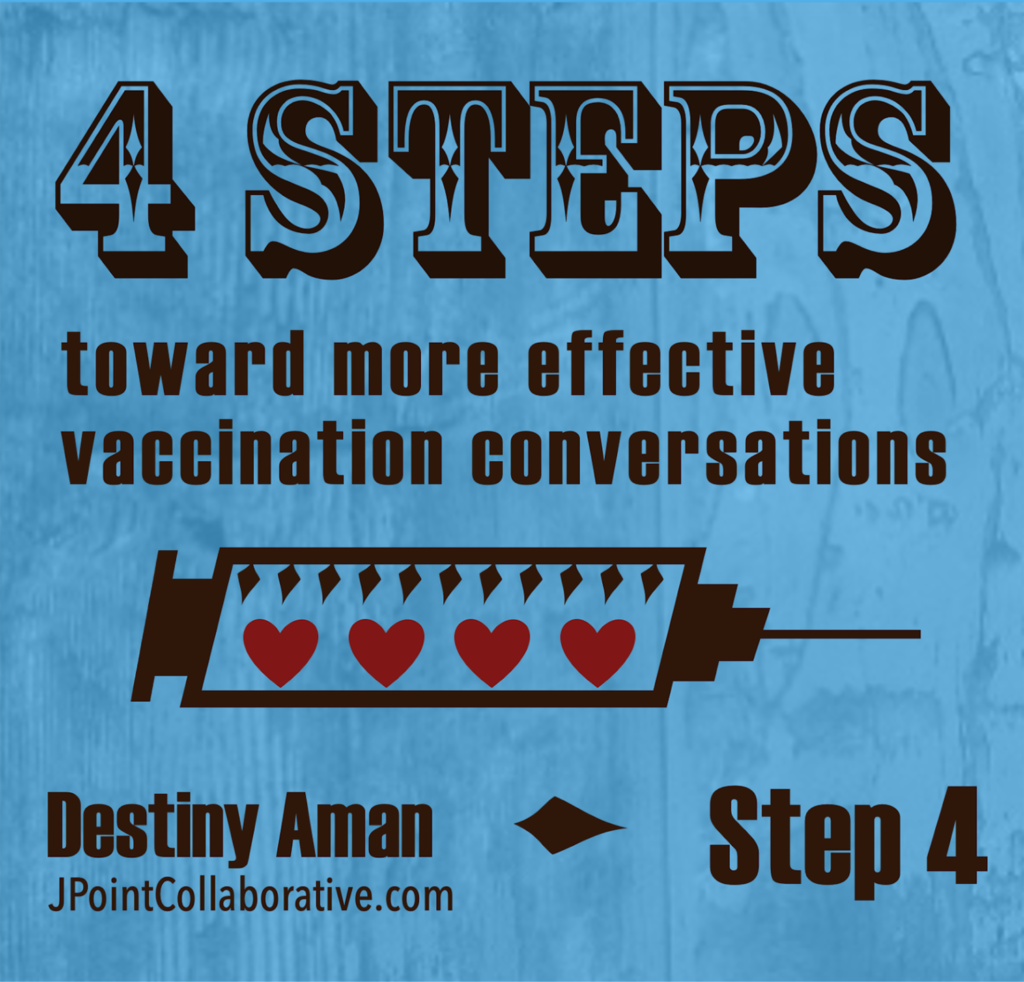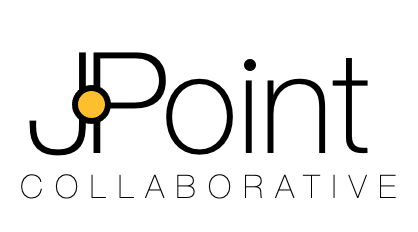Crossing the COVID Vax Divide – Step 4: Make a gracious and respectful exit.


Destiny Aman, Founder, JPoint Collaborative
In this series, we’ve covered how to approach vaccination conversations (Step 1), build rapport with your folks (Step 2), and thoughtfully address barriers from the common ground you have established (Step 3). In this final post, we’re going to talk about the most important step of all, and for many of us, the most difficult. We’re going to discuss how to make a gracious exit.
Also known as the “walk away,” the “back off,” or the “eject button,” this step has two main parts, plus a bonus:
- Part 1: The offering
- Part 2: The pivot
- Bonus: The boundary
The Offering
Behavioral scientists have long understood the power of reciprocal exchange when it comes to human behavior. When people offer to help us, we tend to want to help them back. This impulse is why we receive “free” greeting cards and address labels from charities in the mail around the holidays. These savvy organizations know that people are much more likely to give, when they themselves have received.
With an offering, we’re going to activate this “you scratched my back, I’ll scratch yours” fairness impulse to help nudge our folks toward really considering what we’ve shared with them in the previous steps. Ideally the offering would flow smoothly from the conversation, once you’ve discussed the topic and touched on a couple of barriers.
First, welcome the person to come back to you and continue the conversation at a later point, and then stress unique support that you are willing to provide, judgement-free. For example:
“I don’t know, I just worry about you guys. I know there’s a lot to consider. Honestly, I’m around anytime you want to chat about this stuff…also +
- …I’ve done a lot of research on this and I’m happy to share more of what I’ve learned if you have any questions.”
- …I’d be happy to help you research where to get a J&J vaccine so that you can have a longer break between shots, if you’d like.”
- …the needle thing is rough and super-common…I’d be happy to help you make a plan and make sure you have the support you need while you get it sorted.”
The Pivot
As long as the conversation is flowing, productive, and two-directional, participate as you feel comfortable, but if any of the following signs are evident (at any point in the conversation) it’s time to pivot:
- If your person pushes back hard on what you’ve shared
- If the person starts using canned language that doesn’t sounds like their own
- If you feel yourself getting defensive or frustrated
You really want to avoid a complete conversation shutdown if possible, so don’t hesitate to initiate the pivot if it looks like things are starting to deteriorate. Remember, most people need time to think, to come to terms with the new information, try on the stories that you’ve shared, and translate them into their own new beliefs. Ideally, you want to leave them in a place of more open-mindedness, not a place where they’re super-dug in.
For folks who are really stuck, they’ve invested a lot in their current position, so a very light touch is necessary to avoid cognitive defenses, until or unless the person is driving the conversation and asking you questions in a productive way. If you are the only one talking, that’s an indicator that you need to pivot.
The best way to initiate the pivot is to share an offering, and then simply change the subject. Circle the conversation back to comfortable territory. Ask about things you both enjoy or care about. Aim for a positive topic that will end the conversation with the person feeling good about your relationship – like you care for them.
Then, just leave the topic alone. Ideally, the person will track back to you on their own, with questions or logistical support needs. If they don’t, and you have some physical interaction with this person, then it’s time for the boundary.
Later, and separately: The Boundary
Unfortunately, not everyone is going to come around on the vaccination issue through engagement alone. People are very entrenched on this issue, and many have exploited the political divide, spreading misinformation and disinformation that, while incorrect, resonates very well with people’s existing value structures and is extremely difficult to shift. For these people, a mandate of some kind will likely be needed for them to get vaccinated.
This is not a failure on your part, and it does not mean that your folks are not worthy of respect and care. It does mean that you may have to take some action to ensure that your family remains safe from infection (breakthrough or otherwise) while you’re interacting with this person.
- Discern Risk & Benefit: To start, it’s important for every family to discern their risk tolerance, factoring in immunocompromised individuals or people who can’t get vaccinated. There are some great tools out there for assessing risk tolerance. But beyond objective risk, it’s also very important to consider the benefit space around the activity in question. Not every event is equally important to all people. An airplane ride for work may not have the same benefit as the same airplane ride to visit a dying relative. You may be willing to flex more on your personal protocols, if the benefit of the interaction is high. For a long risk event like the pandemic, being strategic about both risk and benefit is an important way to maintain resilience over the long term and reduce the potential for pandemic fatigue.
- Develop Personal Protocols: Personal (or event) protocols involve what you will require for people to interact with you or enter spaces for which you are responsible. Generally you want to consider your stance on masking, indoor/outdoor use, physical distance/number of people, length of event, and any additional clean air upgrades (like standalone HEPA filtration units) that you’re willing to provide.
- Communicate Firmly & Transparently: Try to resist the urge to soften protocol language (“we ask” versus “we are requiring”). It’s better to be clear and direct, even if it’s a bit awkward. Ambiguous protocols will only lead to confusion and additional stress for attendees. Furthermore, do your best to share this information with people as early as possible – especially if the protocols may matter in their decision to attend. Examples:
- “For Thanksgiving, we will have about a dozen people. Because of Nana’s COPD, we are requiring masks indoors for unvaccinated people (except for eating). We will have several HEPA units running inside, and if the weather’s nice we will eat in the backyard.”
- “Audrey’s birthday party will be mostly outside – we’ll have a firepit set up for s’mores and for folks to warm up if needed. All unvaccinated folks (except the littlest kids) will need to wear a mask when they go indoors. If the weather is bad we’ll hang out in the garage with the doors open and we’ll have hot cider for everyone.”
- “In order to enable us to accommodate more people indoors for the wedding, we are requiring proof of vaccination.”
While it can feel awkward at first to develop and maintain these kinds of protocols, it does get easier over time. Many of us have experienced strained relationships during this pandemic time, while others have grown more intimate and resilient. As the pandemic stretches on, the complexity of these conversations has only grown, and getting better at having them is only going to benefit us, our families, and our communities.
If you have a sticky, multilayered communications problem to solve, or just appreciated this blog series, send us a note. We love this stuff.

